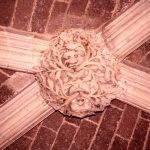The title of my second book in the Lady Apollonia West Country Mystery Series is Plague of a Green Man and the cover picture, shown above, is a “green man” roof boss in the south quire aisle of the cathedral in Exeter, Devon, where the book is set. There is a bit of a stretch in my use of “Green Man” in the title of a medieval mystery because this phrase was not used to describe these foliate faces until 1939.
Besides the green man shown above, I was aware, when living in Exeter, of over fifty instances of these foliate faces in Exeter Cathedral. That number is now known to be over sixty, as I learned in my most recent visit to Exeter in 2018. Also, we have learned through our travels that one will find stone and wood carvings of them in many medieval churches throughout western Europe and England. My inspiration for the idea of “Green Man” developed from my time as a steward and guide at Exeter Cathedral, which also plays an important role in the plot of Plague of a Green Man.
 The presence of “green men” in Christian churches is very mysterious. We do not really know their symbolic meaning in a Christian church. Did they have something to do with a good harvest or with fertility? People have suggested many things. but perhaps the medieval carvers simply added them to the decoration of the church without instruction from clergy? After all, it is thought that a master mason of Exeter Cathedral added carvings of his dog in at least four important locations scattered around the building. One example is the corbel in the Lady Chapel which is shown on the left. Even though it is prominent and easy to see, no one wastes time worrying about whether the dog has hidden symbolic meaning. The beloved puppy is a beautiful representation of human love for a faithful pet.
The presence of “green men” in Christian churches is very mysterious. We do not really know their symbolic meaning in a Christian church. Did they have something to do with a good harvest or with fertility? People have suggested many things. but perhaps the medieval carvers simply added them to the decoration of the church without instruction from clergy? After all, it is thought that a master mason of Exeter Cathedral added carvings of his dog in at least four important locations scattered around the building. One example is the corbel in the Lady Chapel which is shown on the left. Even though it is prominent and easy to see, no one wastes time worrying about whether the dog has hidden symbolic meaning. The beloved puppy is a beautiful representation of human love for a faithful pet.
There are variations in how “green men” are depicted throughout Exeter Cathedral. It is usually a bearded male face, whose hair, beard, and mustache are shown as leafy foliage. Sometimes the leaves may be growing out of its mouth or nostrils or even its eyes. A double green man in the retroquire of Exeter Cathedral with foliage growing from the two mouths is shown on the right.
It is known that the ancient Celtic people of the British Isles, served by the Druids of their tribes, believed in the “cult of the head”. They believed that the human soul resides in the head. The Celts also worshiped nature. Therefore, a foliate face might have represented to a medieval carver his presentation of the human head as residence of the human soul, adorned by nature. We will never know the precise meaning of such symbolism in a great church for there are no records of such things. Further, the Druids, as the priestly class of the Celts committed everything to memory, never wrote anything down.
It was an extraordinary opportunity for me, as an American, to live in Exeter several different years and have daily access to the city’s 14th century Cathedral of St. Peter. Being able to experience the ancient church firsthand and be able to study its history is a high point of my life and the most important source of my desire to place my series in the late 14th century in the West Country of England.
